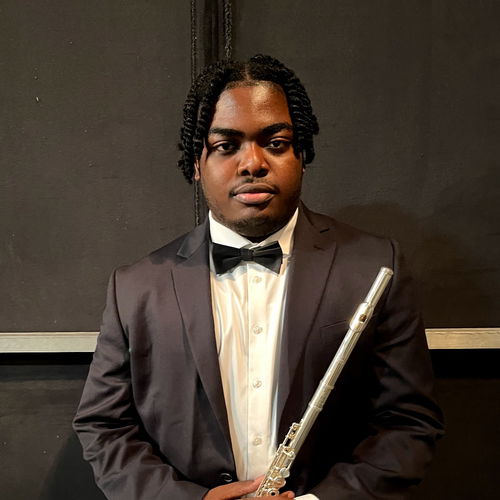A Journey for Flute Trio
Details
Christian Midy full profile / Flute Trio / 3 musicians
Other players: Mina Šuković, Jason Altre
Full program notes
This program showcases the extraordinary versatility of the flute trio across time, place, and genre. From Romantic lyricism to modern minimalism, pastoral scenes to playful dances, each piece explores the unique textures, colors, and expressive power made possible through the delicate interplay of three flutes.
Jacques Castérède – Flûtes en Vacances
French composer Jacques Castérède (1926–2014) brings wit and lightness to this suite of miniatures, whose title translates as “Flutes on Vacation.” Each movement evokes a different playful mood—breezy, sunlit, and delightfully unpredictable. Castérède’s writing is rhythmically crisp, harmonically fresh, and full of conversational dialogue between the three parts. It’s a piece that captures both the leisure of a holiday and the technical brilliance of virtuosic flute playing.
Friedrich Kuhlau – Trio in E minor, Op. 86, No. 1
Though born in Germany, Kuhlau (1786–1832) became a central figure in early 19th-century Danish music. His flute writing was heavily influenced by the Romantic spirit and by the works of his contemporary Beethoven. This trio is rich in lyrical melodies and driving momentum, with each movement offering a clear dramatic arc. The interplay among the flutes is both elegant and spirited, making this piece a cornerstone of the Romantic flute trio repertoire.
Hiroshi Arakawa – Flute Trio No. 1
Japanese composer Hiroshi Arakawa's Flute Trio No. 1 explores space, subtlety, and texture. Drawing on both Western compositional forms and Japanese aesthetic sensibilities, the piece emphasizes nuance and atmosphere. Gentle, flowing lines and thoughtful use of silence evoke images of nature and contemplation. It is music that breathes—a contrast to the more tightly structured works on the program—inviting listeners into a meditative sound world.
Henri Tomasi – Trois Pastorales for Three Flutes
Henri Tomasi (1901–1971) was a French composer known for his expressive melodic writing and love of Mediterranean color. Composed in 1939, Trois Pastorales offers a lush, lyrical exploration of pastoral themes. From birdsong-like motifs to undulating harmonies, the piece paints vivid scenes of rural life. Each movement is a small tone poem, full of charm and emotional nuance, calling on the flutists to blend with both delicacy and dramatic flair.
Gabriel Fauré – Pavane, Op. 50 (arr. Douglas Woodfull-Harris)
Originally written for orchestra and optional chorus, Fauré’s Pavane (1887) has become one of his most beloved works. This arrangement for flute trio preserves its noble elegance and wistful character. The pavane, a Renaissance court dance, is reimagined here with French impressionist grace. Flowing melodic lines and soft harmonies unfold gently, allowing the flutes to shimmer in a texture both rich and intimate. It closes the program with a sense of calm and timeless beauty.
Historical context
Jacques Castérède – Flûtes en Vacances
Composed in the mid-20th century, this piece reflects the postwar French trend toward accessible, light-hearted music designed for enjoyment rather than complexity. Castérède, a Paris Conservatory professor, often wrote pedagogical works that were still musically rich. Flûtes en Vacances fits into a larger tradition of French wind music that emphasizes elegance, clarity, and playfulness, evoking leisure in a world recovering from upheaval.
Friedrich Kuhlau – Trio in E minor, Op. 86, No. 1
Kuhlau composed this trio in the 1820s, during a time when amateur music-making was booming across Europe. As a prolific composer for flute—despite not being a flutist himself—he catered to this rising demand, especially in Denmark, where he was a court musician. The trio reflects early Romantic values: expressive melody, formal clarity, and a democratic interplay between voices, resonant with Beethoven’s chamber ideals.
Hiroshi Arakawa – Flute Trio No. 1
While little biographical information is available about Arakawa, his work reflects a broader 20th- and 21st-century Japanese trend of integrating Western forms with traditional Japanese aesthetics. Post-WWII Japanese composers frequently drew from their cultural heritage while engaging with global musical movements. This piece likely reflects the minimalist and nature-inspired currents seen in the work of other Japanese composers like Toru Takemitsu.
Henri Tomasi – Trois Pastorales
Composed in 1939, on the eve of World War II, this work captures Tomasi’s idyllic and lyrical side, just before the war would change the European musical landscape. A Corsican-born Frenchman, Tomasi infused his works with Mediterranean warmth and often drew inspiration from folklore. Trois Pastorales belongs to the interwar French tradition of wind chamber music, aligning with the pastoral escapism that was common at the time.
Gabriel Fauré – Pavane, Op. 50 (arr. for flutes)
Originally written in 1887, Pavane emerged during the Belle Époque—a period of peace and artistic flourishing in France. Fauré was a central figure in French music, bridging Romanticism and modernism. The work’s blend of old (the Renaissance pavane dance form) and new (19th-century harmonic richness) reflects this transitional period. The piece was later arranged for various ensembles, making it a staple of the impressionist-era sound world.
Videos from this player

 Continue with Facebook
Continue with Facebook
 Continue with Google
Continue with Google
 Continue with Apple
Continue with Apple




